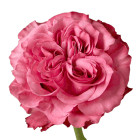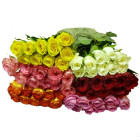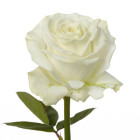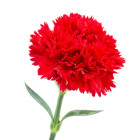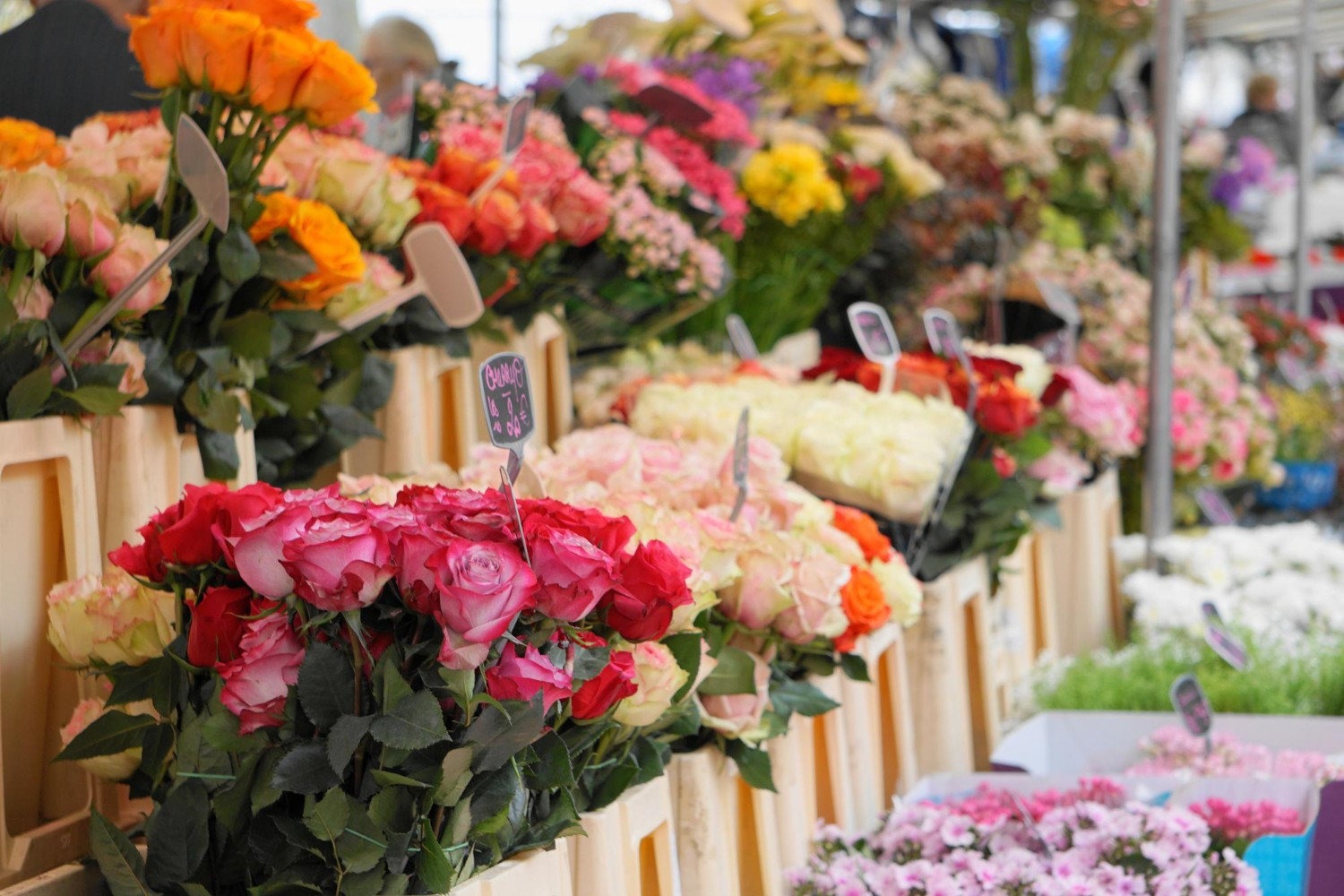
Top 10 longest-lasting cut flowers for bouquets
Every florist wants a bouquet to stay beautiful for as long as possible. People often spend about 3,000 rubles on a gift bouquet (in Moscow up to 5,000), and no one wants the flowers to wilt after a couple of days. The secret is in choosing the right species and varieties with high vase life. Below is a top-10 of the most durable cut flowers—current as of 2025—i.e., those that keep their freshness and decorative look in a bouquet for the longest time. The article is intended for florists, flower-shop owners, and anyone who wants to pick bouquets that last.
1. Chrysanthemums
Chrysanthemums deservedly top the lists of the most durable flowers. Cut chrysanthemums can stand in a vase for up to three weeks or more with minimal care. They are very undemanding and often outlast other stems in a mixed arrangement. The range of forms and colors is huge: single, large-flowered varieties and spray chrysanthemums with daisy, pompon, spider, fully double, or Santini-type heads, and more.
Some modern hybrids are so resilient that they continue to grow and open even after cutting. For example, the “Altaj” variety—bred with market demands in mind—has become a true longevity champion: it handles long transport well and keeps a fresh look for a long time in the vase, continuing to open new florets. Thanks to this exceptional staying power, chrysanthemums are a universal choice for retail and for all kinds of compositions.
2. Carnations
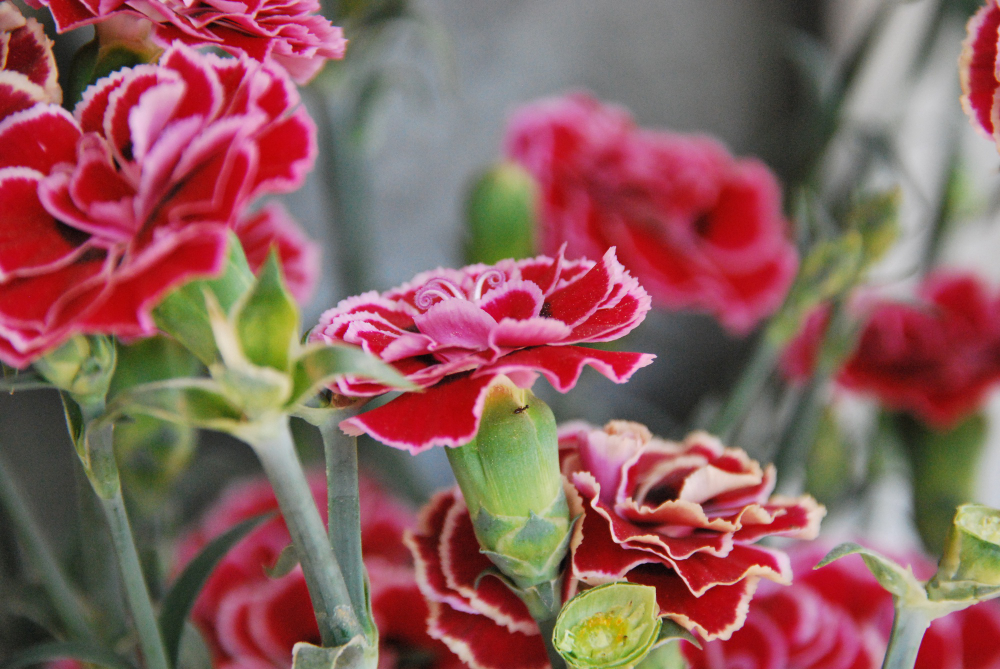
Carnation (Dianthus) is a classic cut flower known for its endurance. Despite the “memorial flower” stereotype, breeders have long produced many new varieties in incredible shades—from delicate pastels to vibrant purples. Mono-bouquets of carnations are back in trend—e.g., wedding bouquets in milky-white or champagne tones—because modern double carnations look lush and elegant.
The main advantage is vase life. Without special care, cut carnations last about a week, and with regular maintenance they stay fresh for 2–3 weeks. For maximum longevity, they prefer clean, room-temperature water and dislike direct sun; in cooler rooms they last even longer. Carnation buds open over time and get larger, so a bouquet can look even fuller by the second or third week than on day one. Florists note that carnations release substances into the water that can shorten the life of more delicate flowers, so avoid placing them in the same vase—or change the water especially often.
3. Orchids (Cymbidium and others)
Red cymbidium orchids are among the most durable and striking orchids for cutting.
Orchids are a symbol of elegance and also offer excellent vase life. Cymbidium in particular is known for longevity: its waxy, large blooms on a cut stem can stay beautiful for up to a month with proper care. In practice, cymbidiums often stand around 30 days in a vase. On the plant, the inflorescences can last up to eight weeks, which explains their remarkable durability when cut.
A few rules matter: orchids like humidity and cool conditions, so use room-temperature water, avoid overheating, and mist the air around them daily (not the petals themselves). Keep them away from ripening fruit—many tropical species are sensitive to ethylene, which accelerates wilting. With careful handling, orchids will stay attractive for 2–3 weeks or more. Besides cymbidiums, florists use Dendrobium sprays and individual Phalaenopsis blooms; these typically last around two weeks as well. Orchids appeal not only for their exclusive look but also because they truly hold up, repaying their higher price with long display life.
4. Alstroemeria
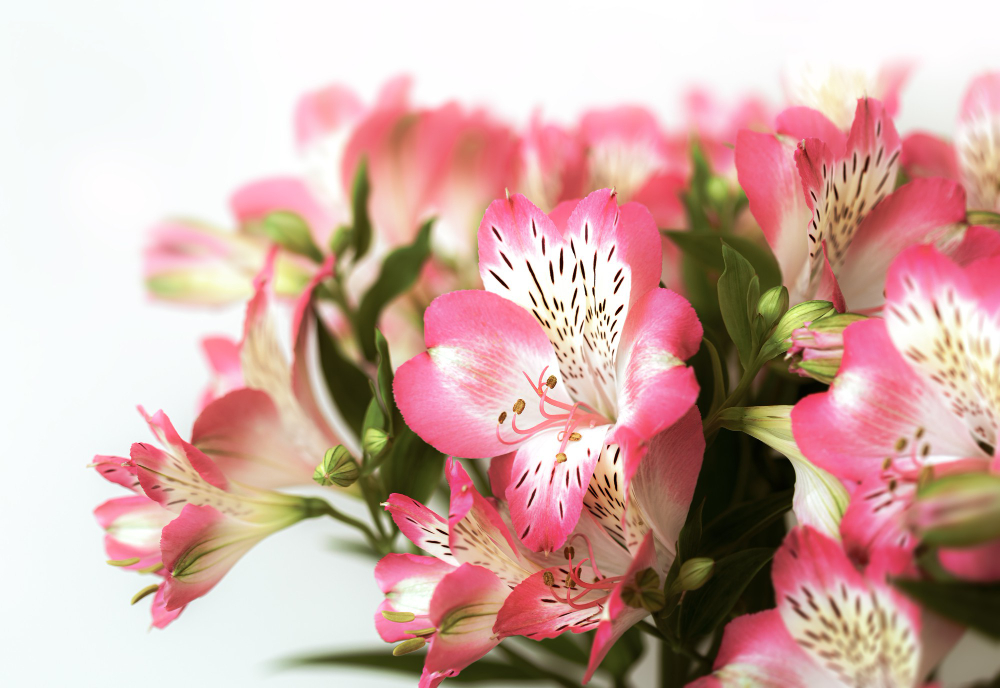
Bright alstroemeria in various shades is a popular, durable flower that can stand in a bouquet for several weeks.
Also known as the Peruvian lily, alstroemeria is a florist’s favorite. These elegant flowers with speckled throats come in white, pink, yellow, lilac, orange, and more, adding volume and delicacy to arrangements. Most importantly, alstroemeria is highly long-lived: an alstroemeria bouquet typically stays fresh for about 14 days, and with good care (regular water changes, stem trimming) can last up to 25 days. That’s essentially 2–3 weeks of beauty, making it one of the most reliable choices.
The secret is its branching: one stem bears many blooms that open in sequence. While some flowers fade, new buds keep opening, so the bouquet looks fresh for a long time. Buy stems with some buds still closed—then you’ll see the full bloom at home and maximize vase life. They don’t drink much, but change the water every two days, as alstroemeria dislikes bacterial build-up. Remove lower leaves to prevent rot in the water. Under these conditions, “lilies of the Incas” will delight you for at least two weeks.
5. Lilies
Lilies are showy, large flowers that are surprisingly robust in the vase. Shops usually sell them in bud, which gives two benefits: buds travel without bruising and then open at home, extending the viewing period. With proper care, cut lilies last about 10–14 days. Each stem bears several buds that open sequentially; removing spent blooms lets new ones open, extending the bouquet’s life.
For maximum longevity: trim stems every 2–3 days and change the water—lilies drink a lot, especially once the big flowers open. Remove the anthers (pollen) as soon as a bloom opens; this prevents staining and slows senescence. Keep the vase away from direct sun and heat sources; cool rooms (~18–20 °C) are ideal. Lilies can release substances that don’t suit other species in a mixed vase, so keep lilies separate or change the water daily. With these steps, even capricious Oriental lilies can perfume your home for two weeks.
6. Lisianthus (Eustoma)
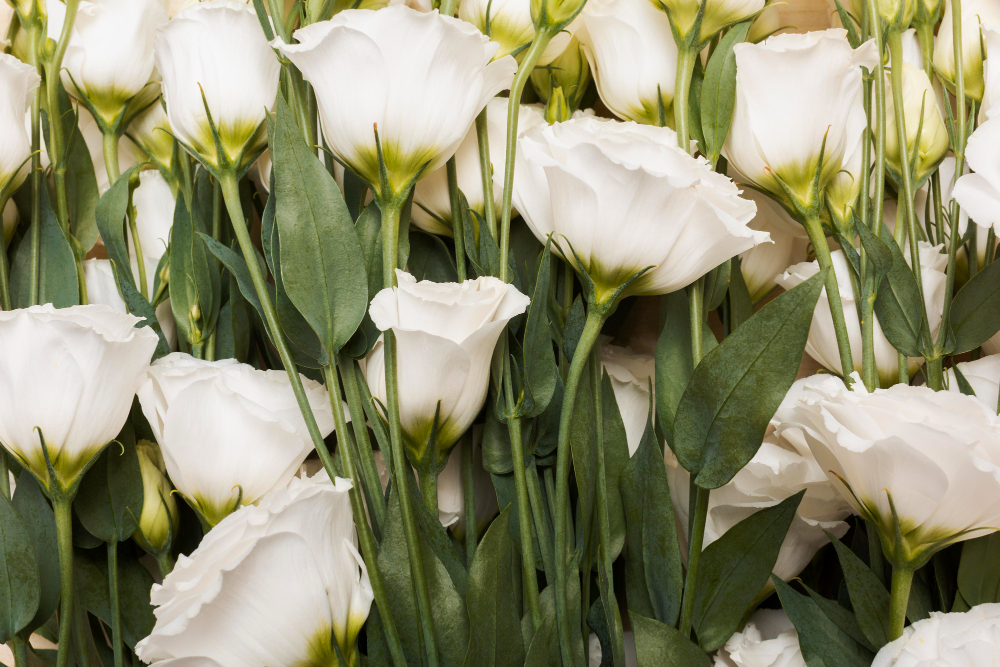
Lisianthus, or eustoma—sometimes called the “Irish rose”—is a graceful flower on a firm, slender stem that’s increasingly popular in modern bouquets. With rose-like buds, it works well in mixes and striking mono-arrangements alike. Despite its delicate look, cut lisianthus is fairly long-lasting: florists note buds can remain fresh for several weeks, which is why it’s a wedding favorite—lasting the whole celebration and then for days in a vase.
Vase life varies by variety—there are single and double forms (doubles are prized for their lush buds) and a wide color range from pure white and pale pink to lilac, blue, and two-tone. Retail stems are often heavily branched, forming a “mini-bouquet” on each stem. With daily trims and removal of spent blooms, these stems typically last about 10–14 days. Lisianthus dislikes heat and drafts; place it in a cool, bright spot out of direct sun. Keep water clean (change every other day) and add flower food to enjoy two weeks of gradual, elegant blooming.
7. Anthuriums
Anthurium is a tropical with an exotic look and remarkable durability. Its inflorescence—a glossy, waxy spathe with a central spadix—has a near-leathery texture, which explains its long vase life. Cut anthuriums often last 3–4 weeks without losing decorative quality. By longevity they rival chrysanthemums and carnations and are frequently named among record-holders (up to four weeks).
In shops you’ll most often find Anthurium andreanum (Andre anthurium) with heart-shaped spathes in red, pink, white, green, or orange. Popular cut varieties include Dakota (red), Acropolis (white), and Midori (green). They’re ideal for contemporary tropical or avant-garde bouquets. For care: before arranging, condition stems for several hours in warm (~40 °C) water. Keep vases away from cold (below ~15 °C the spathe pales) and avoid damaging stems (the sap is caustic). With these steps, anthurium will stay fresh and colorful for at least three weeks.
8. Freesias
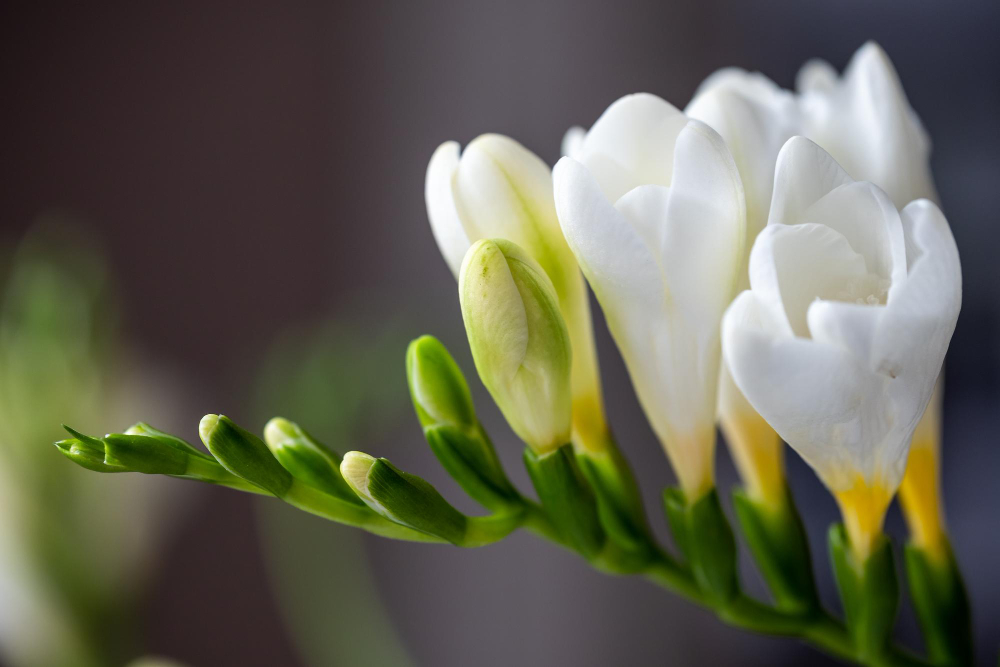
Freesias—refined, bell-shaped blooms with a wonderful fragrance—are valued for both beauty and staying power. On average they last about 10 days in a vase, and with regular water changes and cool conditions they can reach two weeks. White and yellow freesias (often the most fragrant) tend to hold the longest.
To maximize life, buy them in bud (they’re usually sold slightly closed). In the vase, buds open one by one along the stem, giving days of display. Clean water is crucial: change it daily or at least every other day; their delicate stems are sensitive to bacteria. Trim 0.5–1 cm from the stem ends at each change to improve uptake. Freesias like bright, cool locations out of direct sun; moving the bouquet to a cooler room overnight also helps. Treated well, they’ll provide up to two weeks of gentle flowering.
9. Gerberas
Multicolored gerberas are admired not only for their bold look but also for their ability to stay fresh in a vase.
A bright member of the Aster family (akin to sunflowers and daisies), gerbera blooms come in white, yellow, orange, red, pink, magenta, and bicolors. A gerbera bouquet is always cheerful. With proper care, gerberas easily last 7–10 days and often up to two weeks—regulars on “long-lasting” lists.
To extend life: reinforce stems near the base (they’re hollow and can bend)—floral wire or tape helps. Use soft, settled water and keep the water level shallow (about 5–7 cm, just the stem ends). Change water daily and wash the vase; gerberas are bacteria-sensitive. Lightly mist the blooms daily; they absorb moisture through petals too. If a flower droops, submerge the entire stem and head in cool water for 30–60 minutes—often it springs back. With these steps, gerberas can reach 10–14 days.
10. Roses
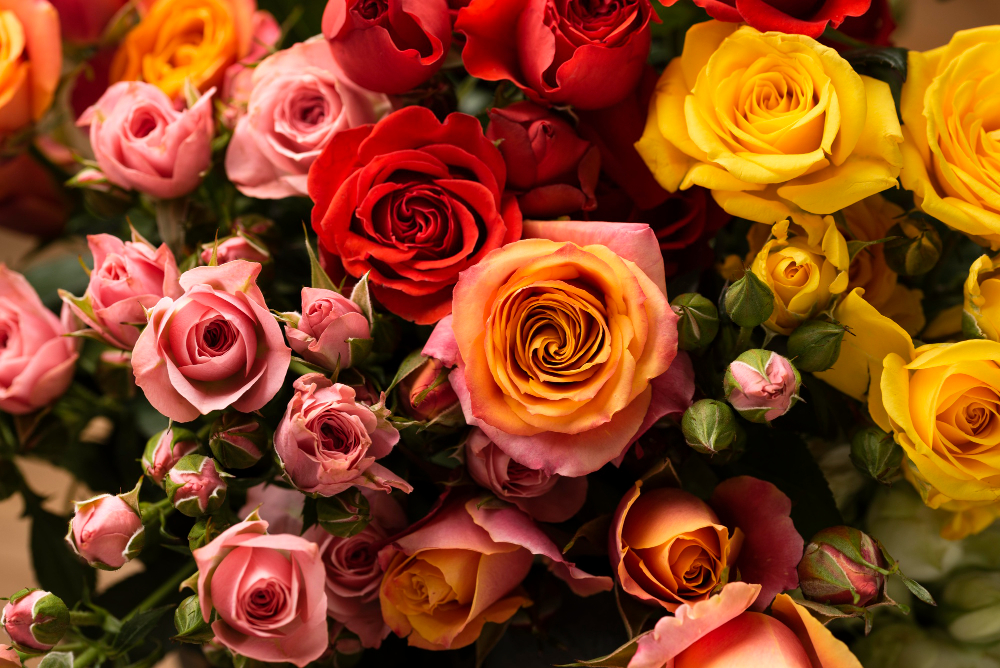
Finally, the market’s perennial favorite—the rose. Often considered more temperamental than carnations or chrysanthemums, the “queen of flowers” can still hold beautifully with the right variety and care. On average, cut roses last 7–10 days, and many modern varieties can delight for up to two weeks. This is especially true of Ecuadorian roses—large-headed varieties on thick, sturdy stems—frequently recommended when longevity matters; they tend to keep a saleable look for up to two weeks with straightforward care.
Varieties noted for staying power include Kahala (red-orange outer petals with a peach-pink center), Lemonade (distinct lime-green rose that lasts even without perfect care), and Hearts (burgundy, lace-petaled rose reminiscent of peonies). Garden-type roses are also very durable—e.g., the Japanese “Princess” series (Princess Maya, Princess Hitomi) and many English roses by David Austin. If you see these available, they’re a safe bet. You can browse current roses on Flora Market.
For maximum life: trim stems by about 1 cm daily or every other day; remove all foliage and thorns below the waterline; change water regularly. Many pros fully refresh the water at least once a day; if you add a commercial food/biocide (e.g., a Chrysal sachet), you can change water every 2–3 days. Use filtered or boiled-and-cooled water with low salts and chlorine. Cool, moderately humid air helps; lightly mist outer guard petals (not the inner bloom), or move the bouquet to a cooler room overnight. With fresh, properly matured stems (firm bud, intact guard petals), even delicate roses will hold for 10–14 days.
How to extend a bouquet’s life: general tips
Even the most durable flowers need attention to reach their full potential. These general guidelines will help any bouquet last longer:
- Change the water regularly. Stagnant water is the main enemy of cut flowers. Replace it daily or at least every other day. Clean water harbors fewer bacteria that cause stem rot. Rinse the vase when changing water to prevent slime on the walls.
- Re-cut the stems. Use a sharp knife to refresh the cut on every stem before placing in the vase, then repeat every 1–2 days. Cut at an angle (~45°) and remove just 0.5–1 cm—this opens capillaries and improves uptake.
- Remove excess foliage. Any leaves that might sit below the waterline should be stripped. Submerged foliage decomposes quickly, fostering bacteria and fouling the water. Leave only leaves above the water.
- Keep bouquets cool. Avoid direct sun, heaters, and drafts. For most bouquets, 18–22 °C is ideal. Overnight, move the vase to the coolest room (e.g., a glazed balcony at ~10–15 °C) to slow senescence.
- Use flower food—or simple home hacks. Commercial preservatives (e.g., Chrysal) supply nutrients and mild biocides and can noticeably extend vase life. If you don’t have them, add a pinch of sugar (nutrition) and a couple of drops of vinegar or clear spirit (disinfection). Some florists even use a splash of lemon-lime soda (sugar + citric acid) or vodka. Don’t overdo it, and keep changing the solution.
-
Avoid incompatible neighbors. Not all flowers share a vase well. Narcissi and hyacinths exude mucilage that harms companions; lilies and carnations can also be poor mixers. Prefer mono-bouquets for potentially “conflicting” species or change water very frequently. Also, keep bouquets away from fruit—ripe produce (especially apples and bananas) emits ethylene that speeds up petal aging.
Follow these tips and choose long-lasting flowers from our top list to significantly extend a bouquet’s “lifespan.” Combine multiple durable species—say, chrysanthemums with alstroemeria and carnations—and your shop display or home vase will stay fresh and attractive for as long as possible. Let flowers please you not just for days but for weeks, bringing beauty and good mood!






